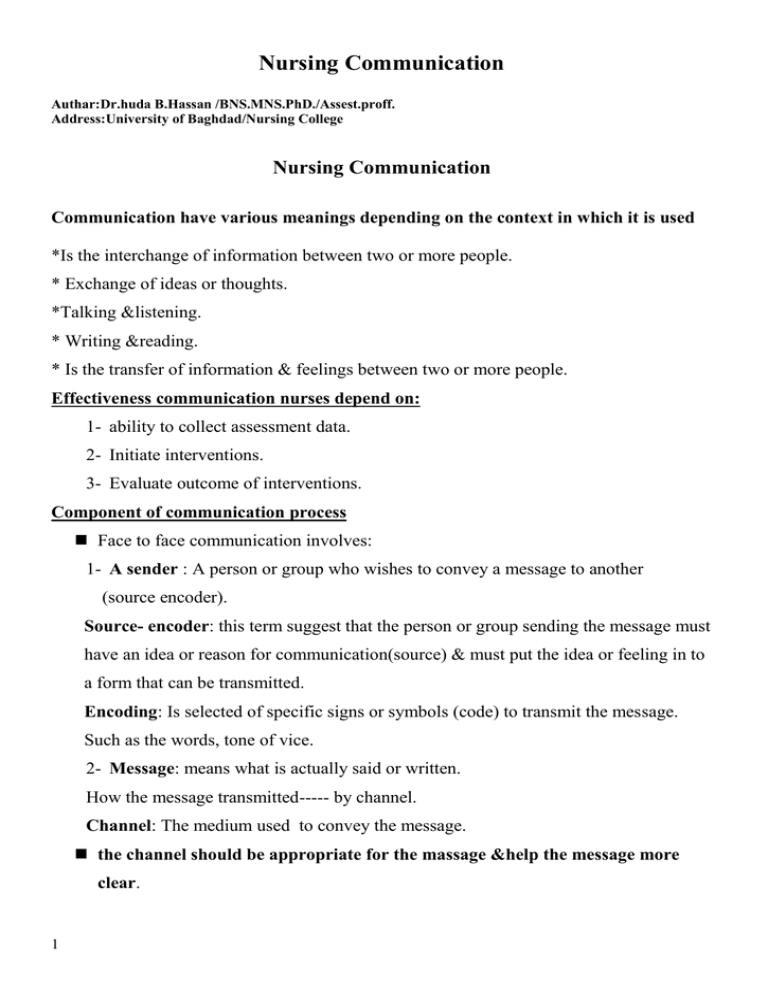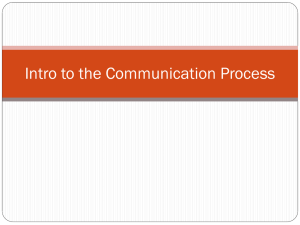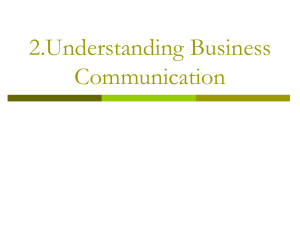Nursing Communication
advertisement

Nursing Communication Authar:Dr.huda B.Hassan /BNS.MNS.PhD./Assest.proff. Address:University of Baghdad/Nursing College Nursing Communication Communication have various meanings depending on the context in which it is used *Is the interchange of information between two or more people. * Exchange of ideas or thoughts. *Talking &listening. * Writing &reading. * Is the transfer of information & feelings between two or more people. Effectiveness communication nurses depend on: 1- ability to collect assessment data. 2- Initiate interventions. 3- Evaluate outcome of interventions. Component of communication process Face to face communication involves: 1- A sender : A person or group who wishes to convey a message to another (source encoder). Source- encoder: this term suggest that the person or group sending the message must have an idea or reason for communication(source) & must put the idea or feeling in to a form that can be transmitted. Encoding: Is selected of specific signs or symbols (code) to transmit the message. Such as the words, tone of vice. 2- Message: means what is actually said or written. How the message transmitted----- by channel. Channel: The medium used to convey the message. the channel should be appropriate for the massage &help the message more clear. 1 Talking face to face a person more effective in some instances than telephoning or writing a message. T.V, Radio. 3- Receiver (listener):Who must listen, observe, and attend this person is the decoder. Decode: means to relate the message perceived to the receiver s storehouse of knowledge & experience & to sort out the meaning of the message. 4- Response ( feed back):Is the message that the receiver returns to the sender. Feedback: can be -- verbal -- Non verbal Modes of communication: 1- Verbal communication. 2- Non verbal communication. Verbal com.: is largely conscious because people choose the words they use. Words depend on: culture Socioeconomic background. Age Education When choosing word the nurse need: 1234567- Pace & intonation. Simplicity. Clarity & brevity. Timing & relevance. Adaptability. Credibility. Humor. Non verbal communication: is sometimes called (body language) It includes gestures, body movement, use of touch, and physical appearance. Nonverbal communication tells other more about what a person is feeling than what is actually said, because nonverbal behavior is controlled less consciously than verbal behavior. 2 Note: Observation and interpreting is essential skill for nurses to develop the clients nonverbal behavior. To observe nonverbal behavior efficiently requires a systematic assessment of the person's overall 1- physical appearance.(clothing and adornments can be source of source) 2-posture & Gait : (walking, erect posture, physical discomfort). 3- Facial expressions. 4- Gestures: hand and body gestures may emphasize and clarity the spoken word, or they may occur without words to indicate a particular feeling or to give a sign. Factors influencing the communication process 1- Development: Language &psychosocial and intellectual development Knowledge of a clients developmental stage will allow the nurse to modify the message accordingly. 2- gender: female and male differently: girls tend to use language to seek confirmation, minimize differences, and establish intimacy. Boys use language to establish independence and negotiate status with a group. 3- Values and perceptions: Values: are standards that influence behavior and perception: are the personal view of an event. 4- Personal space: Is the distance people prefer in interactions with others. Proxemics: is the study of distance between people in their interaction Communication thus alters in accordance with four distances (Tamparo and Lindth,2000) 1- Intimate: Touching 1 ½ feet (Ex: cuddling a baby, touching the sightless. 2- Personal: 1 ½ to 4 feet ( Ex: nurse sitting with clients during giving drugs). 3- Social: 4 to 12 feet. (Ex: the nurse who stands in the doorway and ask a client how are you today. 4- Public: 12- 15 feet: require loud, clear vocalizations ( Ex: health teaching lecture). 5- Territoriality: Is a concept of the space and space things that an individual considers as belonging to the self. 6- Roles and relationships: between sender and receiver affect the communication process. Ex: clients and physician. 3 7- Environment: Comfortable, temperature, excessive noise and poorly ventilated environment can interfere with communication. 8- Congruence: verbal and nonverbal aspects of the message match: Trust prevent miscommunication. 9- Interpersonal Attitude: Attitudes convey beliefs, thoughts, and feelings about people and event. Nurse- clients relationship: (therapeutic relationships) (helping relationship) have two goals: 1- Helps clients manage their problems I living more effectively and develop unused or underused opportunities more fully. 2- Helps clients become better at helping themselves in their everyday lives Phase of therapeutic relationship 1- Pre-interaction phase: similar to the planning stage before interview - the nurse has information about the client before the first face to face meeting ( during taking client name, address, age, medical history) 2- Introductory phase: ( orientation phase) The clients and the nurse closely observe each other and form judgments about the others behavior. Benefit of introductory phase: 1- opening the relationship. 2- Clarifying the problem. 3- Structuring and formulation. 3-Working phase: Benefit 1- Exploring and understanding thoughts and feelings. 2- Facilitating taking action. 4- Termination phase: nurse and client accept feelings of loss. References: 1- Rubenfeld, M., and Scheffer, B.; Critical Thinking in nursing: An Interactive Approach, 6th eddition, J.B. Lippincott Company,2000,PP:-215-16,220-23. 2- Linda, S., Williams, D., and Hopper, P.;Understanding Medical Surgical Nursing 10th eddition, F.A. Davis Company,Philadelphia,2000, PP:-14-15. 4 3- Haber,J., Krainovich, B. et al.;Comprehensive Psychiatric Nursing,14th eddition, Mosby,Atime Mirror company, 2009,PP:122, 127,242,340-341. 5




